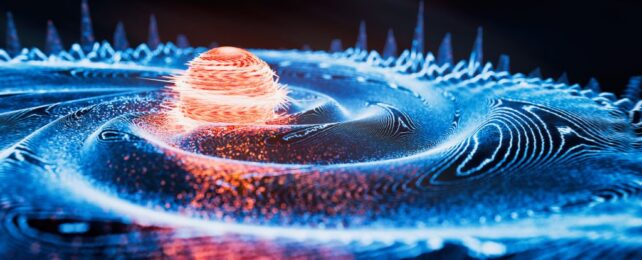Just as ocean waves shape our shores, ripples in space-time may have once set the Universe on an evolutionary path that led to the cosmos as we see it today.
A new theory suggests gravitational waves – rather than hypothetical particles called inflatons – drove the Universe's early expansion, and the redistribution of matter therein.
"For decades, we have tried to understand the early moments of the Universe using models based on elements we have never observed," explains the first author of the paper, theoretical astrophysicist Raúl Jiménez of the University of Barcelona.
"What makes this proposal exciting is its simplicity and verifiability. We are not adding speculative elements, but rather demonstrating that gravity and quantum mechanics may be sufficient to explain how the structure of the cosmos came into being."
Related: Dark Matter May Have Existed Before The Big Bang, Study Finds

We don't know for certain how the very earliest stages of the Universe unfolded following the Big Bang some 13.8 billion years ago. All scientists can do at this point is come up with theories that fit the physics of the Universe we do observe.
Those theories are pretty good, but there are clear shortcomings. Take the JWST's discovery of large numbers of massive galaxies earlier in the Universe than cosmologists expected, for example.
The currently accepted timeline of the Universe's evolution involves a period of rapid expansion, or inflation, just after the Big Bang. From a single, one-dimensional point of infinite density – a singularity, the mathematical description of the Universe just before the Big Bang – the Universe rapidly inflated, puffing up with a hot plasma soup that cooled to form matter.
The inflaton is a speculative particle or quantum field that scientists use to explain cosmological inflation and the surprising smoothness of the cosmos. In theory, the particle drives the rapid expansion of the Universe while still allowing for variations in the density of the plasma soup that eventually condense into black holes, galaxies, stars, and all the other bits and bobs of matter scattered throughout the Universe.
Despite our best efforts, however, physicists have found no other evidence that supports the existence of the inflaton. Jiménez and his colleagues wanted to know if there's another way – if we can explain the early evolution of the Universe using different parameters that rely less on speculative elements.
They started with a very simplified model of the real Universe consistent with general relativity and current observations of the expansion of the Universe, called de Sitter space. Within this field, quantum fluctuations in space-time – that is, gravitational waves – can be generated by a type of turbulence called tensor perturbations.

Gravitational waves are thought to fill the Universe today. They're the ripples generated in space-time by massive disruptions. The ones we can detect currently are generated by collisions between massive, dense objects such as neutron stars and black holes, but physicists believe the entire Universe is ringing with a constant background hum of gravitational waves too large for us to be able to detect (yet).
The researchers found that the gravitational waves generated by tensor perturbations in their space-time model could create density variations in the primordial plasma on their own, as well as drive the early expansion of the Universe.
Eventually, these variations would create clumps dense enough to collapse under gravity and form the seeds of the early Universe – the very first stars and galaxies and black holes.
It's such an elegant solution, and removes the reliance on hypotheticals as the driving force behind the early evolution of the entire Universe, although further work is needed to verify it, of course.
Nevertheless, "Our proposed mechanism could remove the need for a model-dependent scenario: the choice of a scalar field, as the inflaton, to drive inflation," the researchers write.
Their work has been published in Physical Review Research.
